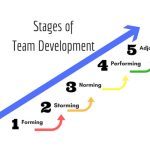
You might have a reasonable size project in your organisation. The activity of the project might occur over several months and have several tasks. Typically, some tasks are dependent upon another. That is, some of the tasks cannot start until other tasks are finished. You can write this down in words but sometimes it can be hard to grasp the meaning of a document that sets out a project like this. One technique for dealing with the management of a project is a Gantt chart. This provides you with a pictorial method of managing your project.
These charts can be made quite sophisticated and complex. For small businesses, you want to avoid this. The purpose of having the chart is to try and make things clearer and simpler for the people that are involved in the project. Too much complexity produces information overload and people will feel overwhelmed. There are some very good software programs that can cope with all this complexity, check out our article Top 5 PM Software with Dynamic Gantt Charts.
A Gantt chart is constructed by firstly listing all the things that you can think of that need to be done in a project. This could be quite a long list. Then, you should group those tasks under specific headings. For a Gantt chart that is to be used for people to look at regularly so that they can get an idea of what is happening in a project, the chart should be just kept to these high-level headings. A more detailed version can be kept by the person running the project.

Advantages of Gantt Charts
● It creates a picture of complexity. I am quite a fan of diagrams and charts. We think in pictures. Therefore, if we can see complex ideas as a picture, this will help our understanding.
● It organises your thoughts. I am also a big fan of the concept of dividing and conquering. A big problem is conquered by dividing it into component parts. A Gantt chart will force you to do this.
● It demonstrates that you know what you’re doing. When you produce a nicely presented Gantt chart with high level tasks properly organized and resources allocated to those tasks, it speaks volumes about whether you are on top of the needs of the project and whether the project will be successful.
● It (should) help you to set realistic time frames. The bars on the chart indicate in which period a particular task or set of tasks will be completed. This can help you to get things in perspective properly. And when you do this, make sure that you think about events in your organisation that have nothing to do with this project that might consume resources and time.
● It can be highly visible. It can be useful to place the chart, or a large version of it, where everyone can see it. This helps to remind people of the objectives and when certain things are going to happen. It is useful if everyone in your enterprise can have a basic level of understanding of what is happening with the project even if they may not be directly involved with it.
Disadvantages of Gantt Charts
● They can become extraordinarily complex. Except for the most simple projects, there will be large numbers of tasks undertaken and resources employed to complete the project. There are software applications that can manage all this complexity (e.g., Mavenlink,Wrike, Smartsheet, AceProject). However, when the project gets to this level, it must be managed by a small number of people (perhaps one) who manages all of the details. Sometimes this does not work so well in a business that is not used to this type of management. Big businesses will frequently employ one or more project managers who are very skilled in this. For a range of reasons, this may not work so well in a smaller enterprise.
● The size of the bar does not indicate the amount of work. Each bar on the chart indicates the time period over which a particular set of tasks will be completed. However, by looking at the bar for a particular set of tasks, you cannot tell what level of resources are required to achieve those tasks. So, a short bar might take 500 man hours while a longer bar may only take 20 man hours. The longer bar may indicate to the uninformed that it is a bigger task, when in fact it is not.
● They need to be constantly updated. As you get into a project, things will change. If you’re going to use a Gantt chart you must have the ability to change the chart easily and frequently. If you don’t do this, it will be ignored. Again, you will probably need software to do this unless you’re keeping your project management at a high level.
● Difficult to see on one sheet of paper. The software products that produce these charts need to be viewed on a computer screen, usually in segments, to be able to see the whole project. It then becomes difficult to show the details of the plan to an audience. Further, you can print out the chart, but this will normally entail quite a large “cut and paste” exercise. If you are going to do this frequently, it can be very time-consuming.
Using a Gantt chart is a tried and true method of managing a project. If you haven’t used a project methodology before, you might like to start with this one.


